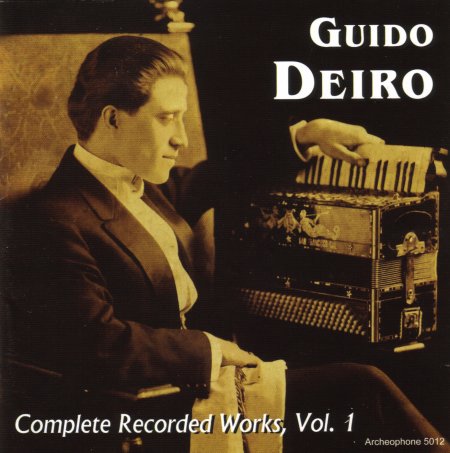
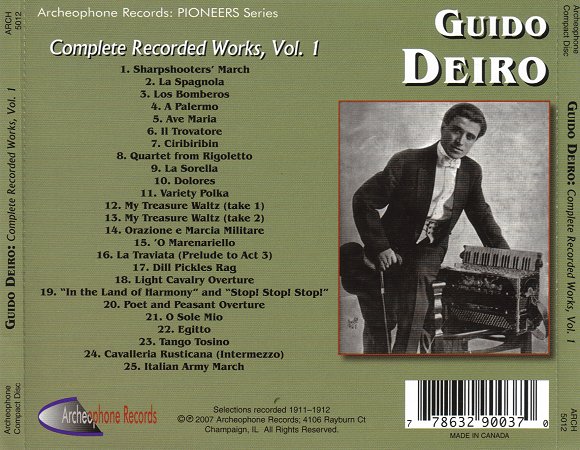
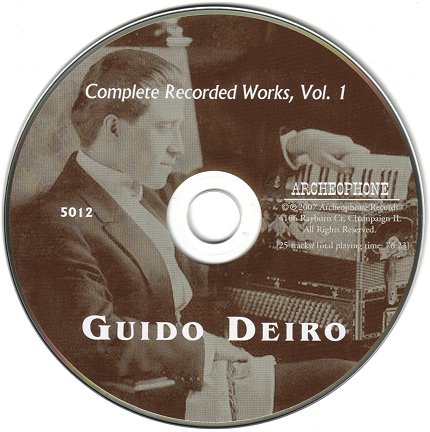
Henry Doktorski Plays The Complete Works of Guido Deiro


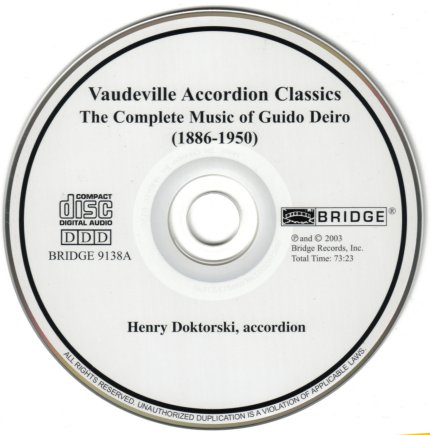
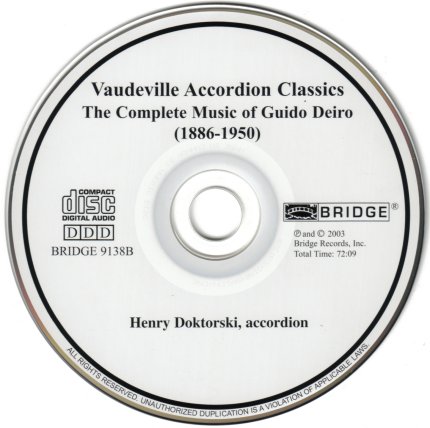
In 1913, Deiro met Mae West, the young vaudeville performer and burgeoning sex symbol. A passionate romance ensued and the couple married secretly. Henry Doktorski's liner notes candidly detail their relationship, and photographs and newspaper clippings from Deiro's own scrapbooks are included in this two-CD set, consisting of 2 hours and 25 minutes of music.
Guido Deiro's delightful compositions are a window onto an era long past -- an artist delighting audiences with soaring melodies, instrumental virtuosity, and abundant high spirits. This anthology will be exuberantly received not only by accordion aficionados, but also by audiophiles in mainstream music circles, much like the rediscovery of Scott Joplin's music, twenty-five years ago.
|
To order a copy of this CD, visit henrydoktorski.com
Henry Doktorski Plays Volume 1 from The Complete Works of Pietro Deiro
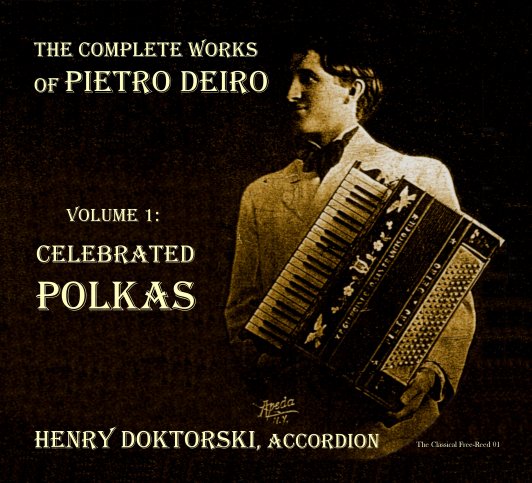
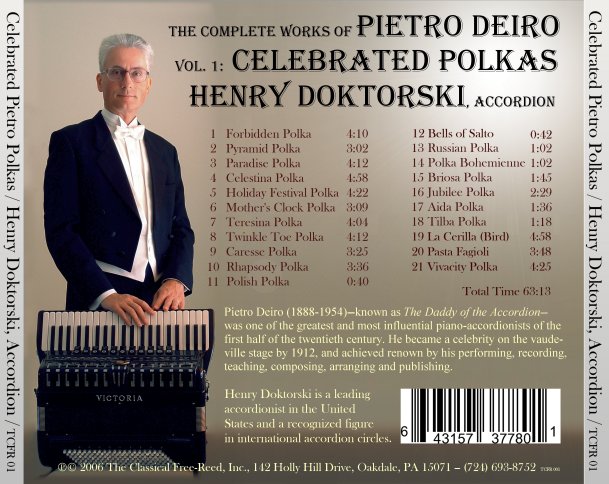
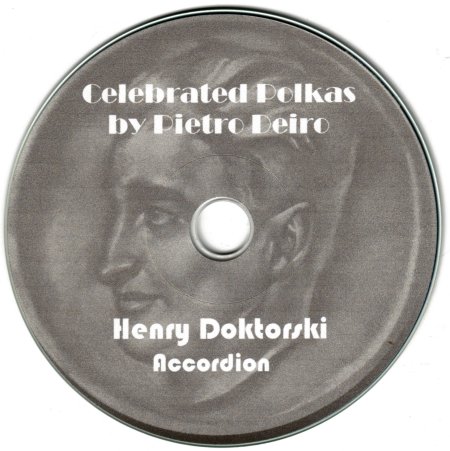
|
Pietro Deiro (1888-1954) is considered one of the greatest and most influential accordionists of the first half of the twentieth century. Born in Salto, Italy, he immigrated to the United States in 1907, and in 1908 began to play the diatonic button-accordion professionally at a saloon in Seattle, Washington.
That same year Pietro s older brother Guido (already an accomplished piano-accordionist in Europe) also immigrated to the United States, and there in Seattle he taught Pietro how to play the piano-accordion. Guido was a sensation and became a vaudeville star in 1910. Pietro, recognizing a good thing, followed in his brother s footsteps, and also became a celebrity on the vaudeville circuit at least by 1912. He earned up to $500 per week: a phenomenal income in those days.
One contemporary 1921 newspaper reviewer praised Pietro s musicianship: What Paderewski is to the piano, Spalding to the violin, and Hans Kronol to the cello, Pietro is to the piano-accordeon. This man takes this instrument, which recently has attained a dignified standing among musicians, and gives it a human voice, a voice that is alive with joy, and dragged down to the depths of sorrow.
Pietro recorded 78 RPM records for Victor and Decca: a total of 147 sides during his career, beginning in 1912. Amazingly, Pietro enjoyed a flourishing recording career even during the Great Depression a remarkable achievement, considering the doldrums the record industry was in at the time. Pietro dominated the solo accordion category in Victor s 1930 Italian catalog with a full eighteen sides (Pietro Frosini could only muster ten).
When the vaudeville industry began to decline, Pietro a shrewd businessman established a music studio in 1928 in Greenwich Village, New York, which attracted so many students that he had to hire a staff of professional teachers. Eventually he established a chain of accordion studios on the East coast.
Recognizing early on that his students needed sheet music, Pietro established the music publishing firm Accordion Music Publishing Company (AMPCO), later known simply as Pietro Deiro Publications. Pietro composed over 200 original works for the accordion and arranged countless other pieces.
Pietro was popular and influential. He appeared as a regular columnist for general music publications such as The Etude and Metronome magazines, and he participated prominently in the main accordion journals of the 1930s and 1940s such as Accordion World and Accordion News. He published his own newsletter called The Pietro Musicordion, he produced his own radio show, and he established a record company devoted to the accordion: AMPCO Records.
In 1936 Italian accordion manufacturers presented him with a parchment scroll and gold plaque for his contributions toward the advancement of the instrument. Pietro was one of the founding members of the American Accordionists Association (created on March 9, 1938), and was elected the association s first president by the board.
One modern scholar, Peter Muir, explained: He [Pietro] effectively became the premiere accordionist in America, a sort of legendary father-figure whose status was embodied by his nickname The Daddy of the Accordion, which he carefully cultivated from early in the decade [beginning in 1930].
The first volume of The Complete Works of Pietro Deiro features his polkas. Subsequent volumes will feature Pietro s waltzes, marches, foxtrots, mazurkas, paso dobles, rumbas, spanish dances, boleros, characteristic dances, 28 preludes, six grand etudes de concert, six overtures and three concerti.
To order a copy of this CD, visit henrydoktorski.com
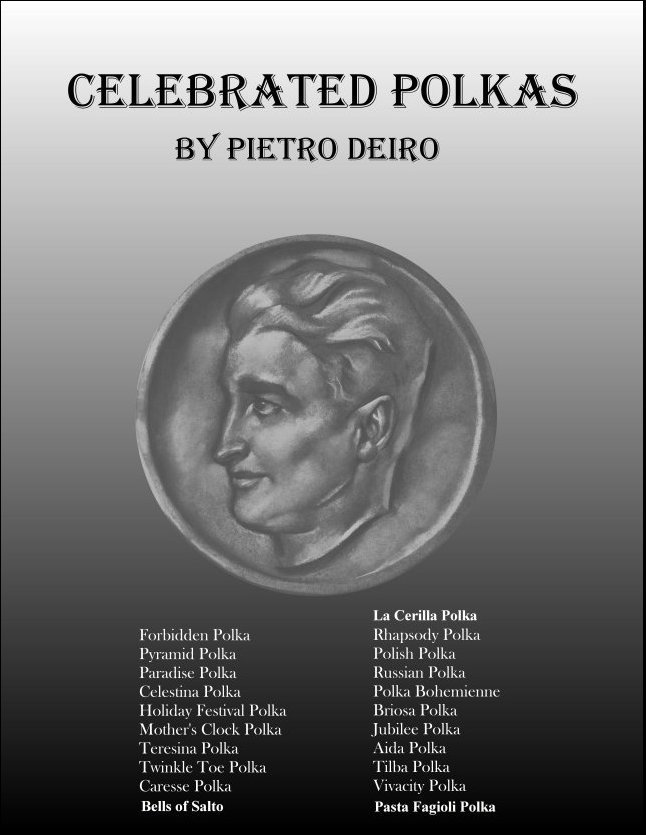
21 Polkas. 40 pages. Book measures 8.5 x 11 inches. Softcover.
1 Forbidden (Proibita) Polka
2 Pyramid Polka
3 Paradise Polka
4 Celestina Polka
5 Holiday (Festival) Polka
6 Mother s Clock Polka
7 Teresina Polka
8 Twinkle Toe Polka
9 Caresse Polka
10 Rhapsody Polka
11 Polish Polka
12 Bells of Salto
13 Russian Polka
14 Polka Bohemienne
15 Briosa Polka
16 Jubilee Polka
17 Aida Polka
18 Tilba Polka
19 La Cerilla (Bird)
20 Pasta Fagioli
21 Vivacity Polka
Now you can read along or play along with Doktorski's CD. This is not a new typesetting; it consists of professionally-bound copies of the original sheet music published in the 1930s, 40s and 50s. All left-hand parts notated in bass clef, except for Vivacity Polka (in treble clef).
Collector's item. A veritable treasure for any accordion library.
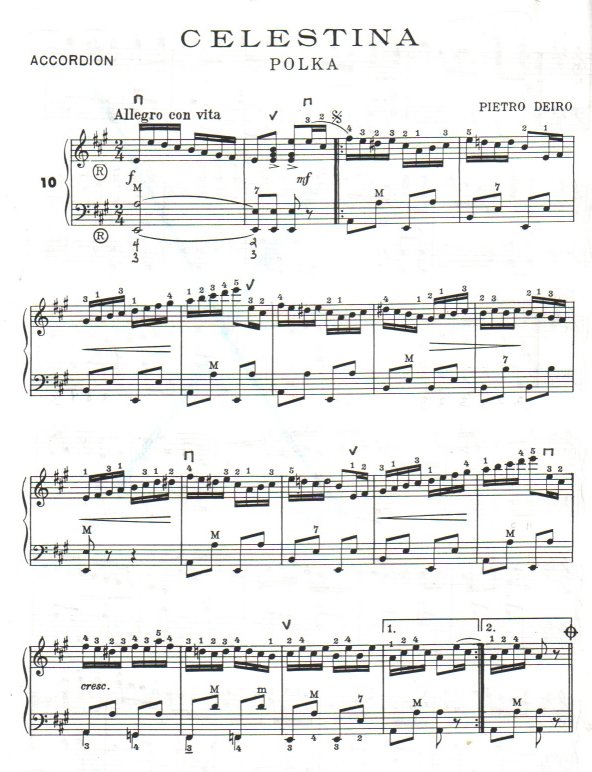
To order a copy of this printed music book, visit henrydoktorski.com
 The Brothers Deiro and Their Accordions, a 12,616-word fifty-page hardcover book by Henry Doktorski, describes in detail the fascinating lives and enduring musical accomplishments of the brothers Pietro and Guido Deiro. This important landmark work has been lauded as the first definitive and authoritative biography of the two greatest piano-accordionists of the early twentieth-century.
The Brothers Deiro and Their Accordions, a 12,616-word fifty-page hardcover book by Henry Doktorski, describes in detail the fascinating lives and enduring musical accomplishments of the brothers Pietro and Guido Deiro. This important landmark work has been lauded as the first definitive and authoritative biography of the two greatest piano-accordionists of the early twentieth-century.
-
hardcover
85 pages
79 photographs including 20 full-page plates
Measures 8.5 x 11 inches
Professional Printing and Binding
Published March 2005
Revised October 2024
The two Italian-American brothers, Guido (1886-1950) and Pietro (1888-1954) Deiro were undoubtedly the two most important piano-accordionists in America during the first decades of the twentieth century. They practically single-handedly introduced and popularized the instrument to millions of people throughout North America and abroad by their vaudeville performances, recordings and published music.
The brothers were also the center of a controversy in 1935, as both claimed to be the first to play the piano-accordion in America. After examining the extensive archives of both brothers, the author has definitively solved the mystery and presented newly-discovered facts and startling conclusions.
The book is organized into two sections: (1) The Brothers Deiro, which describes their lives, careers and achievements, and (2) The Deiro Brothers Accordions, which describes their instruments. Part one consists of nine chapters:
-
Separating Fact from Fiction
The Brothers Deiro in Europe
The Brothers Deiro in America
The Brothers Deiro Achieve Stardom
Discord Between the Brothers Deiro
The Brothers Deiro As Composers
The Death of Vaudeville
The Who Was First? Controversy
The Legacy of the Brothers Deiro
Doktorski said, The factual history of the two brothers Deiro might have remained forever unknown, if not for the acquisition of the substantial archives of Guido and Pietro Deiro by the Center for the Study of Free-Reed Instruments at the City University of New York. I have examined these archives and have been stunned and amazed in many ways. In my book I do not flatter the two men, but attempt to present (as much as possible) an accurate and balanced biographical history describing their accomplishments, their rich and complex personalities, their virtues and vices, and also to dispel some enduring myths about these two pioneers of the piano-accordion. My conclusions are based on source materials (newspaper clippings, recordings, etc.) in the archives, published research by scholars, as well as testimony from contemporaries who knew these two great men.
Doktorski concluded, As a musicologist and author, I am grateful for the opportunity to research and write this history of the famous brothers Deiro and their accordions, and, as a professional concert accordionist, to follow in the footsteps of those two great pioneers who served and continue to serve as inspiration for thousands of piano-accordionists throughout the world. I hope that my book will be appreciated by accordionists, musicologists, and lovers of early twentieth-century popular music.
This is a fascinating book for any accordion enthusiast who has played or just admired the music of Guido and Pietro Deiro. Even the treasure trove of the accordion in America, Ronald Flynn, Edwin Davison, and Edward Chavez's book, The Golden Age of the Accordion, does not go into much detail as does Henry Doktorski's well-researched book. This book has examined very closely much that has been written about these two great accordionists and separated fact from fiction. This book is well written and, although scholarly, is easy to read and full of interesting information about the premiere accordionists in America. I can thoroughly recommend this book to anyone interested in learning more about these pioneers of our beloved instrument. -- Peter Ayres, Accordion World (Uxbridge, Middlesex, England), July/August 2005
Many thanks for the Deiro book which arrived today. It is very nicely done in my view and, more specifically, the writing is excellent, the layout and printing excellent and those photos are very fine! I can comment on this because in Canada I used to produce high-quality brochures and marketing communications material for my clients and wrote most of the material too. -- Roger Nightingale, Secretary of the Waikato Accordion Club (Te Awamutu, New Zealand)
How to order this book:
All customers may order from Amazon. Kindle version available.
| Back |